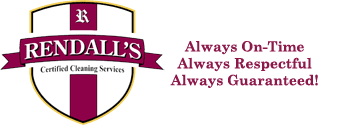Call Rendall's Cleaning: 810-225-2184
Let’s Talk About Carpet Protector
What is carpet protector? Do I need it?
There are 2 different types of carpet protector: There is a soil blocker and a stain blocker. In certain carpet fibers, there are little tiny microscopic holes called dye sites. Those dye sites hold dye. You can imagine a lighter colored carpeting would have the same amount of dye sites as one that is dark, but not all of the dye sites are filled in. Less of the dye sites are filled in on lighter colored carpeting. Carpet mills usually put a protector over top -a “stain blocker”- which helps block those dye sites. Over time those will wear off, especially from traffic, oxidation, heavy spills, chemical spills, etc. Basically things that will ruin those stain blockers. What happens is that it opens up those dye sites so that when you spill Koolaid or something with a dye, it has the tendency to stick to the little tiny dye sites and re-dye the carpeting. Urine is one of those things that does that too because it changes the pH of the carpeting. Urine eats away the stain blocker applied from the manufacturer, and little Fluffy urinates on the carpeting over and over. Over time it starts to etch away those dye blockers and starts to change the color and insert the color of the urine right inside the dye sites. The other type of carpet protector is a soil blocker. A soil blocker resists water and oil based soils like chocolate milk, milk, soda, etc. and changes the surface tension so that the soil stays on top instead of soaking into the carpet fibers.
The best thing to do is after you have your carpets cleaned have us apply a soil blocker. It’s not the same as a stain blocker, but what it does is it helps repel soil from entering the carpet fibers. Let’s say you spill something like coffee on your carpet. If you have the surface tension change and that spill is sitting there, you have a lot more time to clean it up than if it didn’t have carpet protectant on top; it would just soak right in. Even if you have a good soil blocker or dye blocker, if you leave the spot long enough it will eventually find its way down and start to creep up inside from the fibers at the bottom.
We always recommend to get your carpets cleaned on a regularly maintained schedule and have the soil blocker applied once every year or two, depending on factors such as use and types of soils. “Soil Blocker” is the product name that we use and it will help repel these spills, urine or other water or oil based spots that you get.
What’s the difference between Soil Blocker and Scotchgard or Teflon?
Scotchgard and Teflon are two different brands that function similarly. They leave behind a fluoropolymer film that repels soil. We, however, use a product called “Soil Blocker”. It is also a water-based fluoropolymer, but without the questionable chemicals. We also may use an oil-based Soil Blocker protectant, which is used for types of carpets, rugs and upholstery that are not water-safe.
3M Scotchgard and DuPont Teflon work the same way, but the chemistry is different from Soil Blocker. About 20 years ago health concerns were raised surrounding DuPont’s Teflon and 3M’s Scotchgard. When these potential health issues were first revealed, we stopped using them immediately and discovered Soil Blocker, which doesn’t use the fluorochemicals found in Scotchguard and Teflon . As an environmentally-responsible company, we decided long ago to stay away from products that may have issues down the road. We’ve always chosen products that are safe and effective. As our mission statement says, “First, do no harm”. We believe that putting in questionable stuff is best to just stay away from. Especially given that a product like Soil Blocker is far superior, in our experiences. Another reason Soil Blocker is better is that it’s ready to use, meaning it’s not mixed with water. Both ScotchGard and Teflon have to be mixed with water to use. Both Scotchgard and Teflon products add copious amounts of water to the carpet after it’s cleaned. Not to mention, one has to to put on A LOT of Scotchgard or Teflon, which causes overwetting. With SoilBlocker, the water ratio is extremely low. It has just enough water in to help carry the protecant into the dampened fibers. We use the tiny amount of left-over moisture that’s already there from cleaning to help move the soil blocker into the fibers.
In our experience Soil Blocker is a tougher yet safer protectant that uses much less water than competing protectants, and that means better soil resistance and faster drying times so you can use your carpet quickly after it’s cleaned and protected!
Latest posts by Scott Rendall (see all)
- Should I get my new carpets professionally cleaned after construction? - January 8, 2019
- What is the Best Carpet Cleaning Method? - December 12, 2018
- How Often Should I Get My Carpets Cleaned? - October 30, 2018
@ 2025 All Right Reserved
Rendalls Certified Cleaning Services









